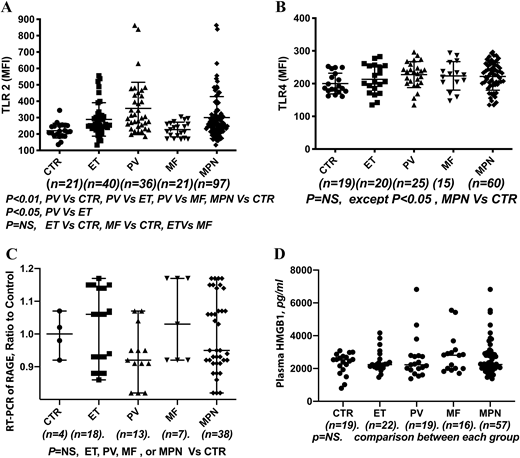Recent evidence of increased constitutional symptoms and inflammatory cytokines in Philadelphia chromosome negative (Ph (-)) MPN suggests that an inflammatory response is important in the pathogenesis of Ph (-) MPN. Toll-like receptors (TLR), Receptor for Advanced Glycation End products (RAGE) and High mobility group protein B1 (HMGB1) are the important pathways for the inflammatory response. All these three important pathway proteins were studied in MPN diseases in the current studies.
Materials and Methods:
TLR assay. TLR 2,3, 4, 7, 9 quantification was performed by immuno-staining of 1×106 mononuclear cells (peripheral blood) which were incubated with fluorescence-conjugated anti-TLR-2,3, 4, 7, 9 antibodies and assayed by flow cytometry. HMGB1assay:HMGB1 ELISA kit from Immuno-Biological Laboratories, Inc. (IBL-America) were used. The plasma samples were diluted four times with the provided sample dilution buffer, and assayed in duplicate according to the manufacturer's suggestion. RAGE (RT-PCR) Assay: Total RNA was extracted from normal control or patient mononuclear cells. Predesigned primers for RAGE, and internal control genes were ordered from Qiagen (Germantown, MD). Real-time PCR was performed using SsoAdvanced™ Universal SYBR® Green Supermix (Bio-Rad, Hercules, CA) on Bio-Rad iQ5 Multicolor Real-Time PCR Detection System. At least three house-keeping genes (ribosomal protein L4, TATA box binding protein, and tubulin-α 1b) were used as normalization controls. The expression of RAGE were compared with each internal control. Average of three was used to calculate the ratio of final patient to normal
Results: Total of 97 patients with MPN were studied 1) TLR: TLR 3,7,9 was not significantly different from controls. But TLR 2 was significantly increased in both PV, as well as in the MPN group when PV, ET and MF were grouped together as MPN (Fig A). TLR 4 was not significantly increased in PV, ET, MF individually but was found to be significantly increased than the controls, when they are grouped together as MPN (Fig B). 2) RAGE: No significant difference was found between ET, PV, MF individually or when they were grouped together as MPN than the controls (Fig C). 3) HMGB1: No significant difference was seen between ET, PV, MF or when they were grouped as MPN (Fig D).
Conclusion: Current study suggests that TLR pathway especially TLR2, and to a lesser extent TLR4 are the important pathways for inflammatory response with increased inflammatory cytokines in MPN, while HMGB1 and RAGE pathways were not different from controls.
No relevant conflicts of interest to declare.
Author notes
Asterisk with author names denotes non-ASH members.


This feature is available to Subscribers Only
Sign In or Create an Account Close Modal